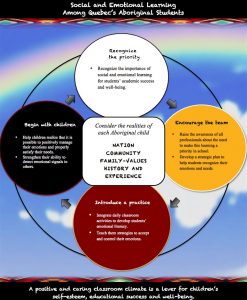Goals

Brief description of the issue
In the Gespe’gewa’gi, boys as young as five years old are lagging behind in terms of their emotional development maturity (DSPGÎM, 2017). At the age of 7 years old, when girls are able to find multiple synonyms to many emotions such as happy, sad, or angry, boys can only find more synonyms than girls to “anger” (BBC, 2018). This difficulty to express emotions aside from anger can have serious consequences on their ability to face a variety of situations over the course of their life. This situation is very concerning, and it shows we must start to teach emotional literacy at a very early age.
The Jasmin Roy Foundation, in collaboration with the Centre des Premières Nations Nikanite and the Secrétariat aux affaires autochtones, has put together a guide intended to educators who want to foster social and emotional learning among children they are taking care of. As stated in the document, “this educational tool is presented in a spirit of openness to the educational realities of Quebec’s First Nations and Inuit. Without being an end in itself, it provides concrete ways for teachers to promote their students’ social and emotional learning.”
You can find the French and English versions of the guide in the Documents section below.
Documents
References
Jasmin Roy Foundation. (2019). Alphabétisation des émotions chez les Premières Nations. https://fondationjasminroy.com/en/initiative/alphabetisation-des-emotions-chez-les-premieres-nations/
